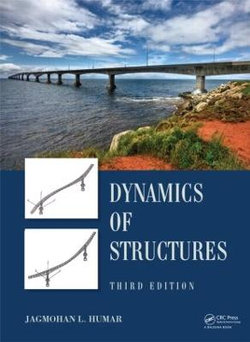The book is an excellent text as well as a practical reference for civil, mechanical and aerospace engineers. It has been identified as a work that is admirable in its lucidity and complete in itself, in the sense that it contains virtually all the material that an engineer who wishes to become skilled in dynamic analysis is likely to need. The book provides comprehensive coverage of the analytical tools required to determine the dynamic response of structures. The topics covered include: formulation of the equations of motion for single- as well as multiple-degrees-of-freedom discrete systems using the principles of both vector mechanics and analytical mechanics; free vibration response; determination of frequencies and mode shapes; forced vibration response to harmonic and general forcing functions; dynamic analysis of continuous systems; wave propagation analysis; finite element analysis, component mode synthesis, and analysis of nonlinear systems. A unique feature of the text is its special emphasis on the application of numerical methods in the analysis of discrete systems.
It provides a comprehensive coverage of both the traditional and state-of-the-art numerical techniques of response analysis, such as analysis by numerical integration of the equations of motion and analysis through frequency domain. A large number of solved examples and exercise problems add to clarity and reader comprehension. The third edition builds on the success of its predecessors and enhances the emphasis on numerical techniques. Thus, significantly expanded coverage is provided of the finite element method and numerical integration of nonlinear equations of motion, which are now covered in separate chapters devoted to them. An entirely new chapter has been added on component mode synthesis, a technique that is suitable for the analysis of very large systems. The book is suitable as a text for one- or two-semester courses at the senior undergraduate level and graduate level in engineering. The book is organized so as to follow the logical steps in the analysis. Thus the formulation of the equations of motion for both single- and multi-degree-of-freedom systems is presented prior to the techniques for the solution of such equations.
However, by appropriate selection of chapters to be covered it is possible to study the single-degree-of-freedom systems from formulation of the equations of motion to their solution prior to studying similar topics for multi-degree-of-freedom systems. A solution manual will be of considerable benefit to teachers offering courses in structural dynamics.
- ISBN:
- 9780415620864
- 9780415620864
-
Category:
- Structural engineering
- Format:
- Hardback
- Publication Date:
-
02-03-2012
- Language:
- English
- Publisher:
- Taylor & Francis Ltd
- Country of origin:
- United Kingdom
- Edition:
- 3rd Edition
- Pages:
- 1056
- Dimensions (mm):
- 246x174x56mm
- Weight:
- 2.04kg
Our Australian supplier has this title on order. You can place a backorder for this title now and we will ship it to you when it becomes available.
While we are unable to provide a delivery estimate, most backorders will be delivered within 120 days. If we are informed by our supplier that the title is no longer available during this time, we will cancel and refund you for this item. Likewise, if no delivery estimate has been provided within 120 days, we will contact our supplier for an update. If there is still no delivery estimate we will then cancel the item and provided you with a refund.
If we are able to secure you a copy of the title, our supplier will despatch it to our Sydney warehouse. Once received we make sure it is in perfect condition and then despatch it to you via the Australia Post eParcel service, which includes online tracking. You will receive a shipping notice from us when this occurs.




Share This Book: